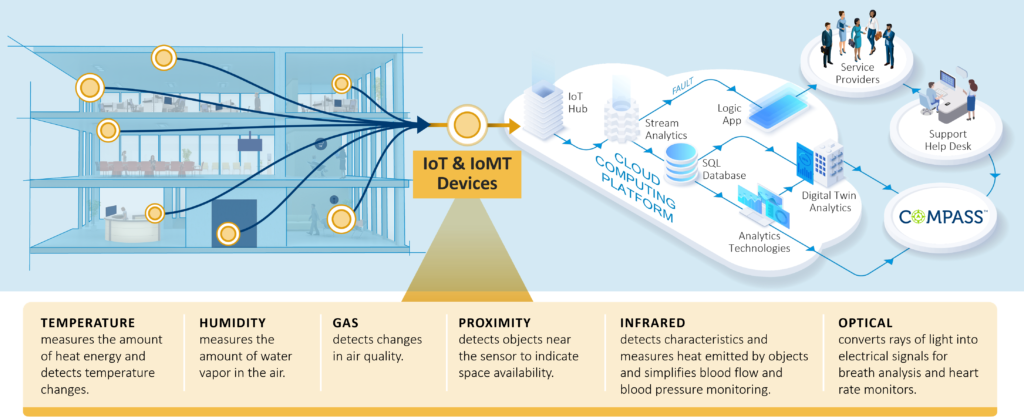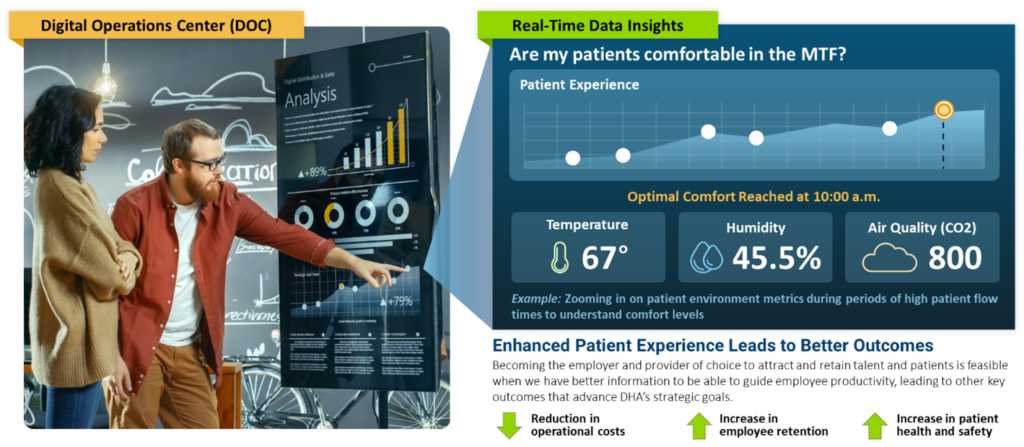Digital Twinning
Published on April 21, 2023The world at large has faced unprecedented changes and as we continue to deal with the aftermath of the post pandemic era, we continue to find new ways of working in health care. Return-to-work hybrid models have normalized daily, back-office scenarios, but a pressing need for end-to-end managed solutions and automated interventions is still urgently needed for the frontline health care worker experience. Despite putting the patient at the center of the health care universe, streamlining clinical workflows in large-scale transformation efforts continues to be evasive, driving the need for fresh interventions. The question is, how can we think differently about the world that we live in now so that we might devise more unique ways of addressing current and enduring challenges in health care? And what can we adopt where we can fuse the new era of digital and physical workspaces to achieve true performance improvement? One way is to leverage digital twin technology.
A digital twin is a virtual representation of a real-world physical system or product that serves as the indistinguishable digital counterpart for practical purposes, such as system simulation, integration, testing, monitoring, and maintenance. A digital twin can, but not necessarily, be used in real time and regularly synchronized within the corresponding physical system. The key evidence of the efficacy of a digital twin is when it is pressure tested in parallel with its physical counterpart. When the system tester of a digital twin cannot reliably distinguish between the digital twin and the physical twin with a high probability, the former is a bona fide digital twin.
Digital twin technology originated long ago. While it is commonly thought to be developed as late as 2002, digital twin technology itself has actually been a concept practiced since the 1960s. NASA adopted basic twinning ideas during this time period for space programming. They brought this concept to life by creating physically duplicated systems at ground level to match the systems in space. For example, NASA developed a digital twin to assess and simulate conditions on board Apollo 13, to ensure its rescue and safe return after oxygen tanks exploded in 1970.
The applications of digital twins for health care are on the rise. As a virtual representation of a clinical workflow, physical treatment facility, or electronic medical record system that spans a patient’s life cycle, we can diagnose breakdowns in patient-centered health care more quickly. In doing so at scale, we can systematically prioritize problems to solve, and end-to-end managed solutions become more readily apparent. Moreover, these solutions are not developed in isolation. Rather, dependencies and interdependencies reveal an additional means for prioritizing micro interventions. Ultimately, the power of generating multiple digital twins is in the ability to interconnect them and reveal the current environment at an aggregate level first. Then, breaking down identified issues to design meaningful solutions, serving to truly connect workplaces and optimize the use of emerging technologies.
The ideal application for digital twins in health care is best illustrated in the diagram below that shows a digital blueprint of a physical workspace (e.g., treatment facility) captures data from Internet of Things (IoT) environment devices and Internet of Medical Things (IoMT) biometric devices unified into a cloud-based hub.

Data from the physical environment combined with digital environment metrics leads to a unified picture of insights. This holistic view of insights, generated from emerging technologies, such as machine learning and artificial intelligence, can help health care delivery organizations make informed decisions to improve the patient experience sooner rather than later. Not only does the digital twin reduce problem-solving time, it can easily reveal financial and people impacts more readily, triggering more opportunities for collaboration and patient care innovation.

At the end of the day, the application of digital twins in this manner leads to a new Digital Operations Center (also known as the DOC), an agency that can produce and maintain meaningful analytics. And, a story that begins with the current state of the patient experience with or without potential gaps that can be closed. And, finally, a pathway to better patient health outcomes.
It might be tempting to think that digital twinning remains in the theoretical state; however, it is already happening. Edera L3C has digitized, streamlined, and automated manual employee onboarding processes as a digital twin. With the invention of Compass™ | Change Navigator, a cloud-based tool designed to automate user journeys, Edera was able to realize several outcomes for the large government healthcare initiative as it continues to implement its electronic medical record. Edera improved organizational change management (OCM) efficiency by closing 96% of parking lot items one day after events, increased speed and scale of system adoption 10 times in under six months, enhanced user experience and engagement from 50% to 90% confidence level post-upskilling interventions, and provided data-driven insights, resulting in a 156% increase in provider attendance.
To find out more, contact [email protected].

Nina Miranda, MS, MCWC, Prosci®
Nina is a health care strategist and visionary with more than 25 years of digital transformation experience serving enterprise-wide growth and operational excellence objectives. Her client delivery roles have ranged from designing and facilitating strategic workshops for executives to managing large-scale digital transformation. She specializes in end-to-end client delivery service offerings, with deep expertise in project management, strategic and capability planning, organizational change management, upskilling, and process improvement initiatives.